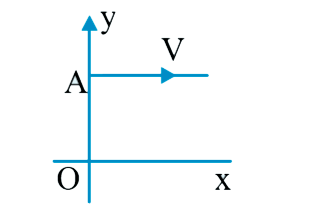A body is moving at a distance parallel to X-axis with a constant velocity. Its angular momentum about the originSolution in Telugu
remains constant
increases
decreases
may increase or decrease
The correct Answer is:A
Step by step video, text & image solution for A body is moving at a distance parallel to X-axis with a constant velocity. Its angular momentum about the origin by Physics experts to help you in doubts & scoring excellent marks in Class 11 exams.
Topper's Solved these Questions
- BOOK - AAKASH SERIESCHAPTER - SYSTEM OF PARTICLES AND ROTATIONAL MOTIONEXERCISE - Exercise-II109videos
SYSTEM OF PARTICLES AND ROTATIONAL MOTION
- BOOK - AAKASH SERIESCHAPTER - SYSTEM OF PARTICLES AND ROTATIONAL MOTIONEXERCISE - PRACTICE EXERCISE99videos
SYSTEM OF PARTICLES AND ROTATIONAL MOTION
- BOOK - AAKASH SERIESCHAPTER - SYSTEM OF PARTICLES AND ROTATIONAL MOTIONEXERCISE - Problems103videos
SYSTEM OF PARTICLES AND ROTATIONAL MOTION
- BOOK - AAKASH SERIESCHAPTER - SURFACE TENSIONEXERCISE - ADDITIONAL PRACTICE EXERCISE (PRACTICE SHEET (ADVANCED) INTEGER TYPE QUESTIONS )8videos
SURFACE TENSION
- BOOK - AAKASH SERIESCHAPTER - THERMAL PROPERTIES OF MATTEREXERCISE - ADDITIONAL PRACTICE EXERCISE (LEVEL - II) PRACTICE SHEET (ADVANCED) Integer/Subjective Type Questions2videos
THERMAL PROPERTIES OF MATTER
Similar Questions
Centre of mass of two particle with masses 2 kg and 1 kg locsted at (1, 0, 1) and (2, 2, 0) has the co - ordinates of
01:42View SolutionThe centre of mass of two particles with masses 2kg and 6 kg located at (1,1,1), (2,2,1) respectively has the coordinates
03:21View SolutionIf the distance between the centres of the atoms of potassium and bromine in KBr (potassium - bromide) molecule is 0.282×10−9m, find the centre of mass of this particle system from potassium (mass of bromine = 80 u, and of potassium = 39 u).
02:40View SolutionIf the work done in blowing a soap bubble of volume 'V' is W, then the work done in blowing a soap bubble of volume '2V' is
03:48View SolutionA constant pressure gas thermometer has a volume of 200cc, 273.2cc and 525 .1cc at 0°C, 100°C and boiling point of sulphur respectively. The resistance possessed by a platinum wire at the same temperatures as above are 2.000Ω,2.778Ωand5.280Ω respectively. Estimate the boiling point of sulphur on the basis of the two sets of observations.
02:34View SolutionA particle is moving in the xy-plane with a constant velocity along a line parallel to the X-axis away from the origin. The magnitude of its angular momentum about the origin.
03:31View SolutionA body of mass m is moving with a constant velocity along a line parallel to the x-axis, away from the origin. Its angular momentum with respect to the origin
02:33View SolutionA particle of mass m is moving with constant velocity v parallel to the x-axis as shown in the figure. Its angular momentum about origin O is
02:45View SolutionA body of mass m is moving with a constant velocity along a line parallel to the x-axis, away from the origin. Calculate its angular momentum with respect to the origin?
 01:38View Solution
01:38View SolutionA particle moves with a constant velocity parallel to the X-axis. Its angular momentum with respect to the origin
02:59View SolutionA particle is moving with a contant velocity along a line parallel to positive X-axis. The magnitude of its angular momentum with respect of the origin is
View Solutionद्रव्यमान m अचर वेग से X-अक्ष के समान्तर एक रेखा में गति कर रहा है। मूलबिन्दु अथवा Z-अक्ष के सापेक्ष इसका कोणीय संवेग ।
03:06View Solutionm द्रव्यमान वाली एक वस्तु x-अक्ष के समांतर नियत वेग से गितशील है । मूल बिंदु के सापेक्ष इसका कोणीय संवेग-
View SolutionA particle moves with a constant velocity parallel to the X-axis. Its angular momentum with respect to the origin
02:37View SolutionA body is moving at a distance parallel to X-axis with a constant velocity. Its angular momentum about the origin
01:45View Solution

